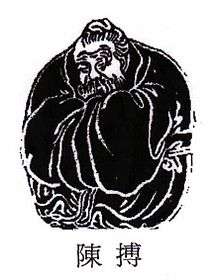Liuhebafa
Liuhebafaquan (六合八法拳; Pinyin: liùhébāfǎquán, literally Six Harmonies Eight Methods Boxing) is an internal Chinese martial art. It has been called "Xinyi Liuhebafa" 心意六合八法拳 and is also referred to as "water boxing" (shuǐquán 水拳) due to its principles.
| Part of a series on |
| Chinese martial arts (Wushu) |
|---|
 |
| Wushu in the world |
|
Historical locations
|
| Wushu athletes/practitioners |
|
Legendary figures
|
|
Historical individuals
|
|
Modern celebrities
|
| Wushu influence |
Note: The art is commonly abbreviated as LHBF, and often referred to by its Cantonese name: Lok Hap Baat Faat
 Chen Tuan / Chen Xi Yi | |
| Also known as | Shuǐquán, 水拳, Xinyi Liuhebafa, 心意六合八法拳 |
|---|---|
| Focus | Striking, weapons training, Qigong |
| Country of origin | |
| Creator | Chén Tuán 陳摶, also known as Chén Xīyí 陳希夷 |
| Famous practitioners | Da Yuan Li Chan Chen Guangdi Chen Helu Yan Guoxing Wu Yihui |
| Parenthood | Wudang Kung Fu |
| Olympic sport | No |
History
The Song Dynasty Taoist sage Chen Tuan (Chén Tuán 陳摶, also known as Chén Xīyí 陳希夷 or by his nickname, Chen Po) is often credited with its origin and development.[1] He was associated with the Huashan Taoist Monastery on Mount Hua in Shaanxi Province.[2]
The Liuhebafa form "Zhú Jī 築基" was taught in the late 1930s in Shanghai and Nanjing by Wu Yihui (1887–1958).[3] It is said he had learned the art from three teachers: Yan Guoxing, Chen Guangdi (who learned the art from a monk, Da Yuan and a Taoist, Li Chan), and Chen Helu.[4]
Many of Wu Yihui's students had martial arts backgrounds and modified the form to merge it with their own knowledge. This is one of several explanations for its similarities with other martial arts such as Xingyiquan, Baguazhang, T'ai chi and Yiquan.
Six Harmonies and Eight Methods
The Six Harmonies and the Eight Methods are the guiding principles of Liuhebafa that give it its name.
Six Harmonies, 六合
Eight Methods, 八法
- 氣 (qì) Chi
- 骨 (gǔ) Bone
- 形 (xíng) Shape
- 隨 (suí) Follow
- 提 (tí) Rise
- 還 (huán) Return
- 勒 (lè) Retain
- 伏 (fú) Conceal
There are other translations and links possible
Forms
The system of Liuhebafa, called Huayue Xiyi Men, as taught by Wu Yihui contains several forms (套路 taòlù), including bare hand and weapons forms as well as qigong methods.[5]
Hand forms
- 三盤十二勢 Sān Pán Shí Èr Shì - 3 Divisions, 12 Spirits (1.Dragon, 2.Phoenix, 3. Tiger, 4.Crane, 5.Leopard, 6.Ape, 7.Bear, 8. Goose, 9.Snake, 10. Hawk, 11.Roc, 12.Kylin)
- 築基 Zhú Jī - Discovering the Foundations
- 呂紅八勢 Lǚ Hóng Bā Shì - 8 Essences of Lǚ Hóng's Fist
- 龍虎戰 Lóng Hǔ Zhàn - Dragon and Tiger Fighting
- 螫龍遊 Zhē Lóng Yóu - Coiled Dragon Swimming
- 螫龍拳 Zhē Lóng Quán - Coiled Dragon Fist
Weapon forms
- 心意棍 Xīn Yì Gùn - Heart of Intent Staff
- 露花刀 Lù Huā Dāo - Dew Mist Broadsword
- 玉川劍 Yù Chuān Jiàn - Jade River Straight Sword
Internal exercises
- 韋佗功 Wéi Tuó Gōng - Standing meditation
- 太陽功 Tài Yáng Gōng - Solar Meditation
- 一杰混元功 Yī Jié Hún Yuán Gōng - Primary Definitive Force
- 先天座 Xiān Tiān Zuò - Pre-Heaven Meditation
- 三盤推手 Sān Pán Tuī Shǒu - 3 Divisions Push Hands
See also
- Chen Tuan
- Wu Yi Hui
- Chan Yik Yan
- Zhang Chang Xin
References
- Glenn D. Newth (2006). Hwa Yu Tai Chi Ch'uan: Unlocking the Mysteries of the Five-Word Song. Blue Snake Books. ISBN 1-5839-4161-4.
- Hua Ching Ni (1992). Life and Teaching of Two Immortals: Chen Tuan. Shrine of the Eternal Breath of Tao, College of Tao & Traditional Chinese Healing. ISBN 0-9370-6448-3.
- "History: Origins, Nanjing, and Others". WaterSpirit-6x8. Retrieved 2016-09-24.
- Jess O'Brien (2007). Nei Jia Quan: Internal Martial Arts. Blue Snake Books. ISBN 1-5839-4199-1.
- "Curriculum". International Liuhebafa Internal Arts Association. Retrieved 2016-09-24.